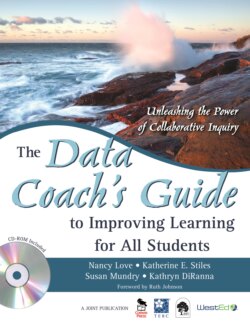Читать книгу The Data Coach's Guide to Improving Learning for All Students - Katherine E. Stiles - Страница 41
Student Learning Improves in Schools Implementing the Using Data Process
ОглавлениеWhen our middle school mathematics Data Team received their most recent state achievement test results, they broke into cheers and tears. That’s ownership!
—Pam Bernabei-Rorrer, Mathematics and Data Coach, Canton City, Ohio
The true power of collaborative inquiry is its potential to improve student learning. In Canton City, Ohio, all four middle schools, comprising 66–82 percent poor students and 30–45 percent African American students, increased the percentage of students scoring proficient or above on the Ohio Proficiency Test in mathematics between 2002–03 and 2004–05. One school doubled the percentage while another more than doubled it. The percentage of African American students passing the Sixth Grade Ohio Proficiency Test in mathematics almost tripled from 2002–03 to 2004–05 (Ohio Department of Education, 2005). (For more details on these and other results, see Handout H1.3 on the CD-ROM for Task 1.)
On the Ohio Seventh and Eighth Grade Achievement Tests, all student groups, including all racial groups, students with special needs, those receiving free and reduced lunch, and males and females, made gains. The percentage of high school students earning proficient or above on the Ohio Graduation Test increased by 25 percentage points from 2004 to 2006. As in the seventh and eighth grade, all student groups made progress (Ohio Department of Education, 2006).
In Clark County School District, Nevada, the Wendell Williams Elementary School (with 100 percent of students eligible for free and reduced lunch, 75 percent African American and 19 percent Hispanic) saw improved student performance in third- and fifth-grade reading and mathematics on the Nevada criterion-referenced test (CRT) in one year. The percentage of students scoring proficient or above in fifth-grade mathematics jumped from 18 percent to 42 percent (Nevada Department of Education, 2005). Similar results were achieved in other participating schools.
In Johnson County, Tennessee, a poor, rural area with 70 percent of students on free or reduced lunch, the schools exceeded the growth rates of some of the wealthiest and highest-performing districts on the state assessment. Most impressive were gains for students with disabilities. In Grades 3, 5, and 8 mathematics, the percentage of students with disabilities proficient in mathematics increased from 36 to 74 percent from 2004 to 2006. In reading for the same grade levels, the percentage proficient increased from 54 to 70 percent (Tennessee Department of Education, 2005, 2006).
Several of the schools participating in the Arizona Rural Systemic Initiative in Mesa, Arizona, serving a high percentage of Native American children, made gains in student achievement on the Arizona State Assessment. For example, San Carlos Junior High School in San Carlos, Arizona, cut the percentage of students in the Falls Far Below category from 95 percent in 2001 to 45 percent in 2005 in eighth-grade mathematics and met Adequate Yearly Progress (Arizona Department of Education, 2005; Eileen Armelin, personal communication, September 29, 2005).
